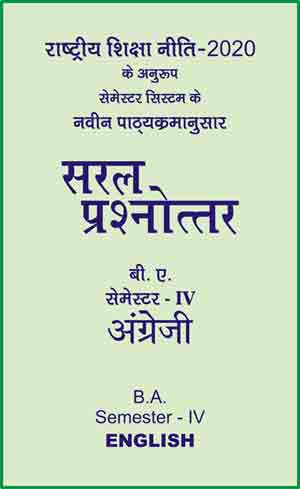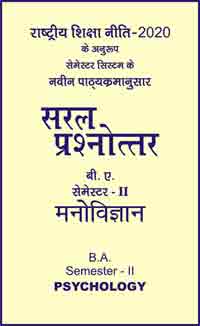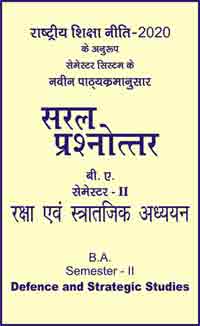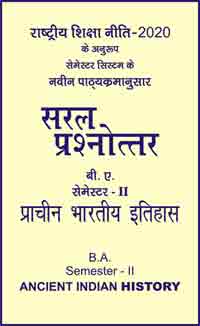|
बी ए - एम ए >> बीए सेमेस्टर-4 अंग्रेजी बीए सेमेस्टर-4 अंग्रेजीसरल प्रश्नोत्तर समूह
|
5 पाठक हैं |
|||||||
बीए सेमेस्टर-4 अंग्रेजी - सरल प्रश्नोत्तर
Important Facts to Remember
Pinjar is a 1950 Punbabi language novel written by notable Indian poet and novelist Amrita Pritam. It is the story of a Hindu girl, Puro, abducted by a Muslim man, Rashid; Puro's parents refuse to accept the defiled girl when she manages to escape from Rashid's home. Pinjar is widely considered one of the outstanding works of Indian fiction set during the period of the Partition of Indian.
Amrita Pritam was 31 in 1950 when she wrote Pinjar, a fictional account of the horrors of Partition that came with Independence in 1947. Pritam herself left Lahore for India that year. Her immortal poem, Ajj Akkhan Waris Shah Nu addressed to the 18th-century poet Waris Shah evokes the tragic events of that time.
Pritam's novella starkly reflects the violence Partition inflicted on women through its chief narrator, Pooro, a Hindu woman who is abducted right before her wedding by Rashid, a Muslim, as an act of revenge. Soon after, a new name, "Hamida" is tattooed on her arm, and she is married to Rashid. Pooro is wiped off her parents' memories, her past erased.
Pinjar, meaning "skeleton", was originally written in Punjabi, and translated into English by Khushwant Singh. The novella begins some years before 1947 (the year of Independence and Partition), when violence is already endemic in the streets of Lahore and Amritsar, twin cities of then undivided Punjab. As the cracks and divides take shape, lingering enmities come to the surface as well. Grudges and insults inflicted a generation and more ago find new life again. Pinjar is about bonds of parenthood, conjugal and filial, and equally urgently, the ties that bind a person to land. When Pooro's mother turns her away, the gesture - one of desperation and despair - could be an apt metaphor for what happened in 1947, when the land itself ruptured in brutal, unexpected ways. Homes became places to flee from and people tied to earth for a long time became refugees. The earth no longer gave succour and was a nurturer no more.
The novel was adapted in the 2003 Hindi film of the same title (Pinjar), starring Urmila Matondkar, Monoj Pajpai and Sanjay Suri in the lead roles. After receiving critical acclaim, the film went on to win the National? Film Award for Best Feature Filim on Nation Integration (3).A Pakistani television series based on the novel titled Ghughi premiered on 25 January 2018 on TV One Pakistan.
Pinjar (The Skeleton) by Amrita Pritam, translated from Punjabi to English by Khushwant Singh is a part of my Literature and Cinema paper. I'll be watching the movie soon in class. I had been anticipating reading this book ever since I discovered Amrita Pritam. A female Punjabi writer who is well-known for being radical in her opinions and life choices. A woman who lived through the partition of Indian and wrote about it without holding back. A woman who left her home forever and in the process, saw many many women being destroyed by the inhumanity of the world.
Pinjar (The Skeleton), a novel by the Jnanpith Laureate Amrita Pritam, is the voice of the huge outcry that resulted due to religious conflicts during India's independence and partition. Amrita Pritam herself migrated from Lahore to India when the former British India was partitioned into the independent states of India and Pakistan and it seems that she was very much moved by the massacres during the time of independence. Less this probably encouraged her to write such an influential novel which was made into an award winning film, Pinjar (2003).
As the title suggests it is also set against the background of the plight of the women who had been turned into mere skeletons due to abduction by the men folk. Seen through the eyes of a Hindu girl Pooro, it gives a picturesque description of the mournful condition that resulted due to the scornful attitude of the two major religious groups of the Hindus and the Muslims against each other during India's partition.
The characters in the novel are both round and flat. The characters of Pooro and her husband Rashida are worth appreciating. However Pooro's parents are seen to have a possessive character as they do everything that will retain the dignity of the family though it may be at the cost of their own family members in contrast to the charismatic character of her own daughter. The novel is of a chronotope type, dealing with the scene during independence although it can be easily related to the scenario associated with subdivisions of a state due to genocide reasons. It appears that the intended audience are both the men and the women folk as the author wants both the oppressors and the oppressed to be aware of the gravity of the situation and raise voices against the same. The author is keen on making the society people aware of the pains undergone by the sufferers and the sympathetic concern they need from them for no fault of their own.
Throughout the novel, Amrita Pritam has nourished the character of Pooro as an epitome of woman power and significance. Although Rashida is also brought up as a dynamic figure, still the flawless description of Pooro clearly shows the author's great desire to glorify the suppressed power contained within the female section as against the greatly cherished position and dominating status of the male population.
The conclusion part of the novel is the best possible one as the author is quite successful in focusing the pious and true meaning of love, unbarred by any religious disparity. The author is also quite successful in emphasising the influence of mass awakening in contrast to sole uprisals as Pooro's brother accepts his wife inspite of the fact of her being abducted by a Muslim. Blend in a stream of emotions and happenings the author takes the readers through a journey of self development and awakening against the hazards of the social and political culprits. The book stands as a testimony to the powerful narration of the typical social strands against the weaker section of the society and leaves no scope of confusion due to the uttermost clarity of language maintained throughout the novel. Moreover, the coherence of the events associated with the novel is worth appreciating.
The most fascinating thing that the novel focuses is the fact that when a social evil surpassed by the victim is on a sole basis it is difficult for the family members to accept the sufferer fearing the disrespect due to the social system. However when the same situation is undergone by a greater number of victims, the society handles the situation with a sympathetic touch as is clearly revealed in the novel where Pooro's sister- in -law is accepted by her husband vowing to treat her with same self respect as before.
Overall, reading the novel was a touching experience as it unreveals the ugly side of the hidden social evils and also the bitterness of the upheavals due to the communal disparities. Moreover the spine chilling description of the sufferings of the female flock in a male dominated society is worth appreciating. Thus, I would refer the book to all my friends for a more pronounced experience about the social issues generally unnoticed by most of us and making the world a better and safer place for all of us to live in. Amrita Pritam's Partition novel Pinjar is a shattering blow to the hegemonic patriarchal set up where a woman's body is considered as a site of contest and her fidelity is constantly questioned there by subjecting her physical anguish and mental trauma.
Amrita Pritam in her novel Pinjar (1950) narrates the gendered experience of the trauma and sufferings of partition. The novel is an exact picture of the violence against women during and after the partition of India in 1947. It portrays the plight of women, their struggle and sufferings due to the perpetrators of violence either, in the name of culture, religion or societal norm. The novel was translated into English by Khushwant Singh as The Skeleton and into French by Denis Matriage. The cinematic adaption of the novel was released in 2003, which won the National Award in the best film category conferred by the Indian Government.
Pinjar is a story of abduction of a young girl Puro by a man (Rashid) of rival religion in order to avenge the family enmity. It is a saga of Puro's journey of transformation from Puro to Hamida, her loss of identity and her agony. The novel is a critique of the society at large which considers the woman as a property to be usurped and used according to its wish, as Menon and Dharin rightly pointed out that: "[the] material, symbolic and political significance of abduction of women was not lost....on the women themselves..... their communion or on.....governments. As a retaliatory measure, it was simultaneously as assertion of identity and humiliation of the rival community through the appropriation of its women".
Pinjar highlights the women's sufferings, exploitation and sacrifices because of their dislocation and abduction during partition. The novelist critically explores the ways in which the destiny of its protagonist Puro eventually becomes the fate of thousands of women at the time of partition.
Amrita Pritam highlights that women are considered merely bodies nothing more than bodies and violation of women's bodies becomes the moral perversion of the community itself.
Through the characters; Puro, Lajo, Taro, Kammo- Amrita tries to unveil the facets of violence against women and her trauma. Here Amrita highlights the fact that women had to constantly prove their innocence and assert their right to dignity in our patriarchal society.
Amrita Pritam's Pinjar(1950) is a Punjabi novel, translated into English as The Skeleton, by Khushwant Singh, depicting the story of a Hindu girl Pooro, abducted by a Muslim boy Rashida and her parents refused to accept the defiled girl due to the fear of communal slaughter. When the British leave India, a chance of migration and starting of new life is presented to her but she decides to stay where her home was. Amrita Pritam herself migrated from Lahore to India when the former British India was partitioned into the independent states of India and Pakistan. It seems that she was very much moved by the massacres during the time of independence. This probably encouraged her to write such an influential novel which was made into an award-winning film, Pinjar(2003).
The novel deals with the image of women during partition era and their real status. It tries to explore the silence around women experiences during that period and depicts the struggle of a woman and her helplessness, highlighting the situation and condition of women, especially in rural areas. Pinjar is such an important novel precisely because of how it conceives the status of women.
As the title of the novel suggests, it is also set against the background of the plight of the women who had been turned into mere skeletons due to the abduction by the men folk. Seen through the eyes of a Hindu girl Pooro, it gives a picturesque description of the mournful condition that resulted due to the scornful attitude of the two-major religious groups of the Hindus and the Muslims against each other during India's partition.
All the women characters of the novel are oppressed by the double yoke of patriarchy and aftermath of colonialism. Either the character of Lajjo who was already married and then kidnapped by a Muslim boy during communal riots and become another victim of the partition and bears the agony or Taaro who was married to the man who was already living with some other woman and just to fulfil the wish of her parents and to satisfy the customs of the society, she agrees to marry that man, presents the helplessness and miserable condition of women. Their narratives strongly challenge a single-dimensional, essentializing notion of a nation that is based upon fixity of religious, gendered and nation identities. They show us the picture of a deracinated and alienated women who have suffered a lot because of the norms and beliefs of the patriarchal society. The solidarity exhibited by woman characters in Pinjar at once renders the boundaries of religion, porous and projects the relation between them as complex and nuanced rather than as pre-determined by biases.
Pinjar is the depiction of the experience of the partition specially from women's point of view. The novel is a critique of the society at large which sees the woman's body as a site of crazy battle for land and territories. It is the women's bodies that are reduced to skeletons-living skeletons, lunatic skeletons. The lust of men has not even spared the mad woman who is "neither young nor attractive; she is just a lump of flesh without a mind to go with it.... a living skeleton... a lunatic skeleton.... a skeleton picked to its bones by kites and vultures." The novel depicts how religion becomes a powerful source that constrains women in the name of owner and chastity.
Throughout the novel, Amrita Pritam has nourished the character of Pooro as an epitome of women power and significance. Although, Rashida is also brought up as a dynamic figure, still the flawless description of Pooro clearly shows the author's great desire to glorify the suppressed power contained within the female section as against the greatly cherished position and dominating status of the mail population.
Amrita Pritam's pen started to follow her thoughts at a very young age of twelve or thirteen. Since then, she has to her credit 27 novels and novelettes, 8 collections of poems and 38 other prose works which includes short stories, travelogues and also her auto-biography. Her novels include Pinjar, Doctor Dev, Naagmani, Yatri, Aaj Ke Patte, Koi Nahi Janta, Yah Sach Hai, Terhavaa Sooraj, Unyas Din, Jalaa Vatan, Jebkatren, Kacdhi Sadak, Ek thi Anita, Dilli Ki Galiyan, Kore Kagaj, Ghonsla, Unke Hastakshar, Saagar Aur Spiyan, Bandol Darvaja, Aag ki Lakeer, Naa Raadha Naa Rukmani, Ek Sawal, Ariel, Bulaawaal, Ek thi Sarla, Eksimo Smile and Pighalti Chattaan.
|
|||||














